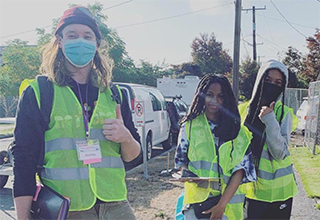April 4, 2024

A UW team member, left, with volunteers from the Duwamish Valley Youth Corps as they conduct door-to-door surveys. (Photo courtesy of Paulina Lopez)
Researchers at the NIEHS-funded Environmental Health Sciences (EHS) Core Center at the University of Washington (UW) conducted a survey with residents in Seattle’s Duwamish Valley to find out community priorities, strengths, and needs regarding climate change. Led by Nicole Errett, Ph.D., director of the center’s Community Engagement Core, and Paulina Lopez, executive director of the Duwamish River Community Coalition (DRCC), the team published their findings in a report and an online story map. This information will inform actions to build climate resilience in the Duwamish Valley.
Communities along the Duwamish River in Seattle face socioeconomic and environmental injustices that leave them vulnerable to climate change. For example, Duwamish Valley is more susceptible to flooding than other parts of the city and has some of the worst air quality in Seattle. In response to community concerns about climate change, the DRCC launched a climate justice program to assess ways to help residents.
To support this effort, the UW EHS Core Center partnered with the DRCC, the City of Seattle, and other local, state, and federal agencies. Volunteers, including some from the Duwamish Valley Youth Corps, were trained by UW researchers, with support from the U.S. Centers for Disease Control and Prevention, to go door-to-door to conduct the survey.
Survey results showed that residents prioritized environmental health issues, like poor air quality, and identified the need for more green space and community-led projects to build climate resilience in the Duwamish Valley. These results were visually represented in the story map to make the findings more accessible.
“We wanted the survey results to reach a broader audience,” explained Lisa Hayward, Ph.D., the UW EHS Core Center’s co-manager of community engagement. “The story map lets us reach people who wouldn’t read the report, and it provides insight into people who are affected by climate change in the Duwamish Valley.”
The story map includes anecdotes from community members and highlights some of the people behind the report.
“The story map lets us humanize the data,” said Hayward. “We believe storytelling encourages people to care about the implications of the survey and the resilience-building initiatives that will stem from its findings.”


